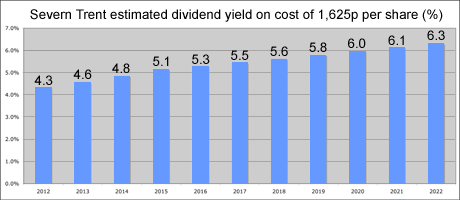Should you buy Severn Trent’s index-linked bond?
Utility company Severn Trent is launching an inflation-linked bond for retail investors. Should you invest? Or is there a better option? Phil Oakley takes a look.
Severn Trent is launching a Retail Price Index (RPI) linked bond aimed at retail investors. It will pay a real rate of interest (ie after inflation) of 1.3% a year for ten years and will mature in July 2022.
So is it one to add to your portfolio? Or should you ignore it? Let's take a look.
Why is Severn Trent doing this?
There are lots of reasons. On top of the money water companies get from customers' bills, they need extra cash to maintain and upgrade their water networks.
MoneyWeek
Subscribe to MoneyWeek today and get your first six magazine issues absolutely FREE

Sign up to Money Morning
Don't miss the latest investment and personal finances news, market analysis, plus money-saving tips with our free twice-daily newsletter
Don't miss the latest investment and personal finances news, market analysis, plus money-saving tips with our free twice-daily newsletter
As a result, water companies regularly raise money from bond investors, and prefer to do this before asking their shareholders for more money.
But why go to retail investors for money rather than institutions? Well, private investors, fed up with the disappointing performance of the stock markets for many years, have been putting more money into bonds.
The trouble is that there are only a small number of bonds that retail investors can realistically buy. So many have put their money into bond funds, managed by professional investors, which are more expensive.
Companies are now wising up to the fact that they have a whole market of untapped lending available if they decide to approach retail investors direct.
And why index linked? This makes a bond more attractive to small investors because there are so few retail investment products available that offer to protect the purchasing power of their money.
National Savings & Investments (NS&I) has withdrawn its popular index-linked savings bonds. There are a few RPI-linked savings products on offer elsewhere, but there's not much to choose from.
Last year National Grid exploited this gap in the market and issued an index-linked bond to private investors. And in general in recent years, regulated electricity and water companies have been taking on more inflation-linked debt. It makes sense for them to do so.
That's because most of their assets and revenues are linked to changes in the RPI. So given that these companies borrow a lot of money, it makes sense to have some loans and interest payments linked to the RPI to hedge against risk.
For example, if inflation were to turn to deflation, the interest payable on index-linked debt could actually go down, whereas it would not with most other forms of debt.
So how will Severn Trent's bond work?
You can apply for the bonds through your stockbroker - you must do so before the close of business on 4 July. The bonds will be sold in multiples of £100, and the minimum initial amount that you can purchase is £2,000.
MoneyWeek videos

Buying bonds? Watch this first
Seven things you should know before you buy retail bonds.
Watch all of Tim's videos here
Interest will be payable twice a year on 11 January and 11 July, with the first payment in January 2013. The bonds are not covered by the Financial Services Compensation Scheme (FSCS) in other words, this isn't like sticking your money in a bank account.
Remember, no tax will be deducted from interest payments, but you may still have a tax liability. The bonds can be held in Individual Savings Accounts (Isa) and Sipps.
So what about the interest rate? The interest you get on the bond will take into account changes in the rate of inflation. In this case, inflation will be based on the RPI measure. Bear with me here I'm going to spell out how this is calculated, because these RPI-linked bonds can sometimes be hard to follow.
Say you buy £2,000 worth or 20 of these bonds, which start trading on 11 July 2012. In January 2013, your first interest payment will be altered to take into account the effect of inflation.
The inflation rate used will be from eight months before the issue date (so the RPI in November 2011 of 238.5) to the rate eight months before the payment date (May 2012, or 242.4).
That's a percentage change of roughly 1.64%. That rate is applied to the coupon payment.
So in January 2013, here's what you'll get: each £100 bond pays a £1.30 annual coupon, so you get 65p (because this is a semi-annual payment you get two a year) per £100.
On top of that 65p, you get the adjustment for inflation. So that's an extra 1.64% of that 65p - that comes out at around 1.07p. So that's a total of 66.07p per £100.
You've got £2,000, so multiply by 20 to get your first payment of just over £13.21.
Here's the formula: £100 x 1.3%/2 x (242.4/238.5) x 20 = £13.21.
This equates to an annualised income return of 1.32%.
If we have a period of deflation, you may get an income return of less than 1.3%.
At the end of ten years in July 2022, the amount you get back will depend on the rate of inflation between November 2011 and November 2021. Assuming that inflation averages 3% per year for the next ten years, this means that for your £2,000 initial investment you will get back:
£2000 x (320.5/238.5) = £2,687.60.
However, it's worth noting that if there was a period of deflation over ten years, Severn Trent cannot pay you back less than the £2,000 you originally invested.
If you do want to sell before the bond matures, then you can sell them through a stockbroker. Be aware that you may end up getting back more or less than you initially invested if you do this.
So are these bonds a buy?
The good thing about bonds is that you always get paid before shareholders do. And Severn Trent is a solid company that is unlikely to go bankrupt.
So if you like that security; like the fact that you should get your £2,000 back; and think that inflation might take off; then these bonds might be worth considering.
That said, you might end up getting a better real rate of return from buying Severn Trent shares. It's impossible to know of course, where the share price will be in 2022, but the real rate of income could be better than the bond. Let me explain.
Severn Trent's current annual dividend is 70.1p per share. Its stated dividend policy is to increase dividends by 3% more than the RPI until March 2015. This would give the stock a dividend of 83.5p at that date. Based on the current share price of 1,625p that equates to a yield on cost of 5.13% or 2% more than the current RPI inflation of 3.1%.
The long-term dividends you can expect from water companies are highly dependent on regulation. The water regulator, OFWAT, sets the amount Severn Trent can charge its customers every five years. It's worth bearing in mind that Severn Trent had to cut its dividend following the last regulatory review in 2010. It's possible that it could be cut again.
But just for argument's sake, lets say that Severn Trent can keep increasing its dividend by an inflation rate of 3% per year after 2015. With assets and revenues heavily linked to RPI this could be possible.

Based on this scenario, you could have a yield on cost of 6.3% in 2022 or 3% more than inflation. If you held the bond, your yield on cost would be 1.75% plus an increase in capital value of £687.60.
Let's assume that you held some Severn Trent shares for the same period as the bond and could sell the shares in ten years' time for the same price you bought them for of 1,625p.
If we then look at the annualised rates of return of the two investments, you would get 4.34% holding the bond and 5.43% holding the shares (assuming a 3% inflation rate).
You can argue that this makes sense you're getting a higher yield with the shares to compensate for the higher risk but in any case, neither return looks that impressive.
So if you are hunting around the utility sector, you might do better to look elsewhere. For example, you could look at the equity of a similar inflation-linked business such as National Grid, which currently offers a prospective dividend yield of 6.2% at its current share price of 657p.
Get the latest financial news, insights and expert analysis from our award-winning MoneyWeek team, to help you understand what really matters when it comes to your finances.
Phil spent 13 years as an investment analyst for both stockbroking and fund management companies.
After graduating with a MSc in International Banking, Economics & Finance from Liverpool Business School in 1996, Phil went to work for BWD Rensburg, a Liverpool based investment manager. In 2001, he joined ABN AMRO as a transport analyst. After a brief spell as a food retail analyst, he spent five years with ABN's very successful UK Smaller Companies team where he covered engineering, transport and support services stocks.
In 2007, Phil joined Halbis Capital Management as a European equities analyst. He began writing for MoneyWeek in 2010.
-
 How gifting money this Christmas could lower your inheritance tax bill
How gifting money this Christmas could lower your inheritance tax billCash is an easy and quick present to give over Christmas – and it could protect some of your estate from the taxman down the line
-
 £100 contactless card limit to be lifted
£100 contactless card limit to be liftedConsumers will be able to set their own contactless limits from March 2026, under new rules from the Financial Conduct Authority
-
 How do NS&I savings account rates compare? Advantages of using government-backed bank
How do NS&I savings account rates compare? Advantages of using government-backed bankAdvice NS&I savings accounts offer security and tax-efficient options for your money. But how do its interest rates compare to the rest of the market?
-
 Green finance is set to be the most powerful financial repression tool yet
Green finance is set to be the most powerful financial repression tool yetAnalysis The government has launched its “green savings bond” that offers investors just 0.65%. But that pitiful return is in many ways the point of “green” finance. John Stepek explains why.